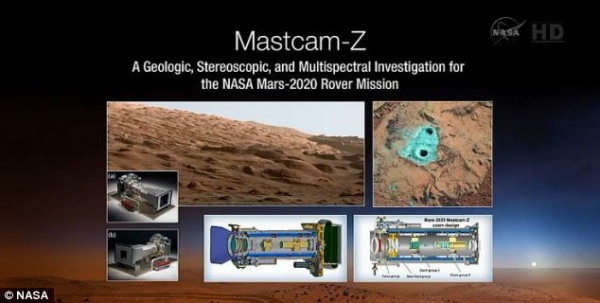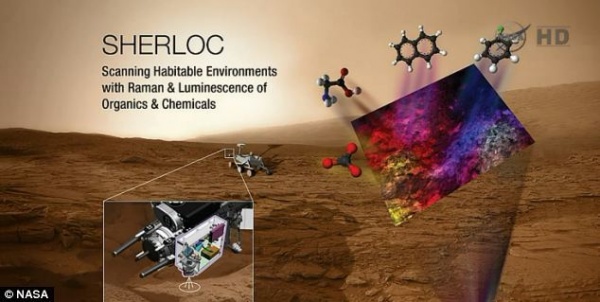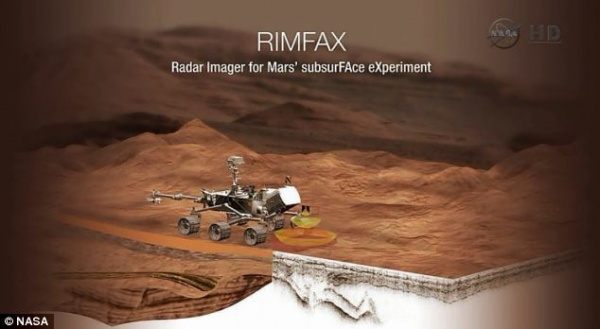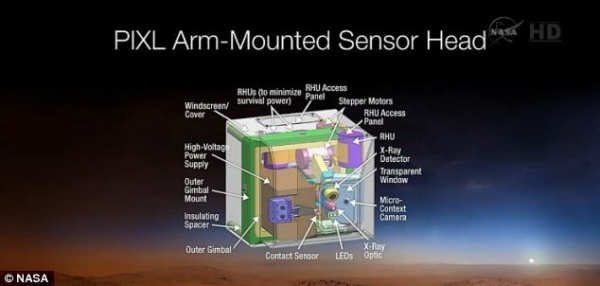NASA has announced a large number of new instruments designed for the 2020 rover, including a camera on the mast, to provide better imaging capabilities. The spectrometer Sherloc will also provide small-scale imaging and use an ultraviolet (UV) laser to determine small-scale mineralogy and discover organic compounds. RIMFAX is a ground penetrating radar capable of providing a resolution of centimeters to the subsurface geological structure. An X-ray fluorescence spectrometer has a built-in high-definition imager that can determine the small-scale chemical composition of the surface material of Mars. PIXL can make this a reality by detecting and analyzing chemical elements in more detail than ever before. In order to save time and money, the Mars 2020 Rover will share the body of NASA’s “Curiousâ€, which is currently looking for life on this red planet. The new Rover will also use the same landing system as "Curious", using an unprecedented chassis and "sky crane" to reach the surface of Mars. According to foreign media reports, NASA has unveiled a mysterious version of the "Cursic" enhanced version of the Rover. It contains seven powerful instruments that will help scientists solve the mystery of this red planet. One of the most exciting of these is Moxie, an instrument that can absorb carbon dioxide in the atmosphere of Mars and deliver pure oxygen, which can be used as a rocket fuel, or one day for human breathing. The 2020 Rover will also have the capability to capture the picture of this red planet using a device called the mast camera MastCam. NASA scientists say that this capability will "make you very shocked." The Bureau’s astronaut, Deputy Secretary John Glensfield, said: “It will be a step closer to the human experience of examining Mars. You will feel like you are really on this red planet. The feeling will be very fantastic.†MastCam will have a 3.6:1 zoom feature, capable of resolving images about 1mm in size in the near field, and recognizing objects 3 to 4cm in diameter at 328 feet (100 meters) apart. . In addition to this instrument, SuperCam will provide imaging, chemical composition analysis, and mineralogy capabilities. It can also find the organic compounds in the rocks from afar. At the same time, Scanning Habitable Environments with Raman & Luminescence for Organics and Chemicals, Sherloc will also provide small-scale imaging and use of a UV laser to determine small-scale mineralogy. Found organic compounds. Glensfield said: "The rocks on Mars will tell us an interesting story. They will tell us a history of Mars, the story is written in these minerals. This Mars Rover will go there and put this story. Excavate.†In fact, an important feature of this rover is that its 99-pound (45-kilogram) payload will be able to bring intact samples back to earth without pressing the sample like the Curiosity. broken. Meda (a group of sensors) will measure temperature, wind speed and direction, pressure, relative humidity and dust particle size and shape. James Luther, vice president of the space technology mission council responsible for these projects, said: "NASA's space technology project can work with human exploration and the Mars 2020 rover research team to prove that we have the ability to collect the atmosphere of Mars, and We are excited to convert its rich carbon dioxide into pure oxygen, and this technical verification will pave the way for our lower-cost mission to Mars, where oxygen is a life support and Rocket propulsion is essential." NASA's mission to Mars 2020 will carry these instruments randomly. This task is based on a mobile laboratory created by "Curious." The "mobile laboratory" will be powered by a radioisotope generator that will provide the Mars with at least one full Martian operating life, equivalent to 687 days on Earth. NASA said it received 58 bids in January for issues related to scientific research and expedition technology equipment that the Mars 2020 mission will be carrying on a random basis. This is twice the average bid submitted in past instrument competitions and it indicates that people are very interested in exploring this red planet. NASA hopes that the 2020 rover can be used to demonstrate the skills needed for human Mars exploration and finding signs of life. For example, the vehicle can perform measurements and technical demonstrations to help human adventure designers understand any risk factors caused by Mars dust. The 2020 Mars will also be used to demonstrate how to collect carbon dioxide, which will be a useful resource for oxygen and rocket fuels. The car will use NASA's "curios" body, which is currently looking for life on Mars, and has begun to run toward its final destination. The new Rover will also use the same landing system as "Curious", using an unprecedented chassis and "sky crane" to reach the surface of Mars. As a result, the Mars 2020 mission is expected to cost $1.5 billion, which is $1 billion less than its predecessor, the Curiosity. This will be used to collect new designs of rock samples, marking an important step in the implementation of President Obama's mandate: to send humankind to Mars by the 1930s. NASA deputy director Glens Field said: "The establishment of research and exploration goals is an important turning point in preparing for the next Mars mission." In April, Charles Bolton, head of the U.S. space program, said: “If humans want to survive indefinitely, we must become a multi-planet animal. We must go to Mars and use it as one of our other solar systems. Springboard.†Bolton announced a series of “springboard†plans to Mars, including “capturing†an asteroid, planting plants in space, and using 3D printers for random equipment maintenance. The Mars 2020 mission is designed to build on the achievements of Curiosity and other Mars missions. The "Courage" and "Opportunity" rover vehicles, as well as several other orbiting vehicles, have found historical evidence of water on Mars. The "Curious" also confirmed that the past environmental conditions of this red planet may have been suitable for living microorganisms to survive. According to the scientific definition group, finding the signs of past life is the next logical step. The rover will use its instruments for visual, mineralogical, and chemical analysis to understand the environment surrounding the landing site. It also needs to determine the biological characteristics of rocks and soil samples, which may have been formed by the action of organisms. The chairman of the Scientific Definition Team, Jack-Mastad, professor of geological sciences at Brown University in Providence, said: "The Mars 2020 mission concept does not believe that there was life on Mars. However, given the recent discovery of 'Curious', There may seem to be life on this red planet in the past, so we should begin the search for the signs of life. No matter what we learn from it, we will be learning about the existence of the early life on Earth and the life outside the Earth. There is a lot of progress in terms of possibilities.†The next-generation Mars Rover also plans to collect and package up to 31 rock samples and soil samples, and intends to bring them back to earth through a later task, making it more authoritative in the laboratory. Analysis.
Although there are many types of tapping screws, they all have the following similarities: Round head Tapping screw,hex tapping screw,flat head tapping screw,pan head tapping screw,truss head tapping screw Shenzhen Lanejoy Technology Co.,LTD , https://www.baking-rack.com




(1) are generally made of carbonized carbon steel (accounting for 99% of total production). It can also be made of stainless steel or non-ferrous metals.
(2) The product must be heat treated. Carbon steel tapping screws must be carbonized and stainless steel tapping screws must be solution hardened. In order to make tapping screws to meet the requirements of the standard of mechanical properties and performance.
(3) The product surface hardness is high, the core toughness is good. That is, "soft inside strong outside". This is a major feature of tapping Screw performance requirements. If the surface hardness is low, it can not be screwed into the matrix; If the core toughness is poor, a twist will break, can not be used. So "inside soft outside steel" is self-tapping screw to meet the use of performance, very important requirements.
(4) The surface of the product needs surface protection treatment, generally electroplating treatment. Some product surface must be treated by phosphate (photostatting), such as wall panel self - tapping screws for photostatting.
(5) Production by cold heading process. It is recommended to use high-speed cold heading machine and high-speed wire rolling machine or high-speed planetary wire rolling machine. High speed is emphasized here to ensure product quality. Only the head of tapping screw produced by high-speed machine is well formed and the thread quality is high.